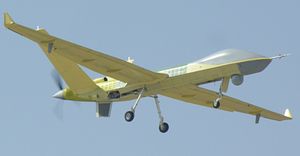Satellite imagery may have identified the unnamed first export customer of China’s next-generation medium-altitude long-endurance and strike-capable Wing Loong II unnamed aerial vehicle (UAV).
According to satellite imagery taken at the remote Qusahwirah Air Base near the United Arab Emirates’ (UAE) border with Oman and Saudi Arabia, three drones matching Wing Loong II dimensions were spotted in October 2017, Jane’s Defense Weekly revealed this month.
“The United Arab Emirates (UAE) air force has almost certainly acquired the AVIC Wing Loong II [UAV],” Jane’s concludes.
In February 2017, Chinese state-owned Aviation Industry Corporation of China (AVIC) announced that it had scored its first and biggest oversea purchase order for the Wing Loong II by an undisclosed buyer.
To date, neither the size of the order nor the price tag for Chinese-made drones have been revealed. Furthermore, neither AVIC nor the UAE government have publicly confirmed the purchase.
The Wing Loong II has been primarily designed and developed for export and has been marketed by China’s defense industry as a more cost-effective alternative to the U.S.-made General Atomics MQ-1 Predator. (The per-unit price is estimated at around $1-2 million, compared to the Predator at $4 million, or the MQ-9 Reaper at $30 million.)
As I reported in March 2017:
China’s latest strike-capable drone has been designed and developed by the Chengdu Aircraft Design and Research Institute, a subsidiary of AVIC. With an overall length of 11 meters, a wingspan of 20.5 meters, and a height of 4.1 meters, the Wing Loong II UAV was first publicly revealed at the Airshow China 2016 in November 2016. At the airshow, China Aerospace Science and Technology Corporation’s (CASC) for the first time publicly displayed a prototype of its latest and most capable attack and reconnaissance UAV, the Caihong 5 (CH-5), or Rainbow 5.
The Wing Loong II is an upgraded variant of the Wing Loong UAV first introduced into service with the People’s Liberation Army Air Force in 2008. An export version of the drone has been sold to a number of international customers including Egypt, Saudi Arabia, the United Arab Emirates, Nigeria, Uzbekistan and Kazakhstan. (…) Pakistan has also expressed interested in the weapon system. In terms of size and payload, the original Wing Loong combat drone is comparable to the General Atomics MQ-1 Predator, [was] slated to be retired by the U.S. Air Force by the end of [2017].
The Wing Loong II can carry various weapons systems:
The Wing Loong II UAV can carry a number of different missiles and bombs including Lan Jian 7 (Blue Arrow 7) laser-guided air-to-surface missiles, TG100 laser/INS/GPS-guided bombs, and the AR-1/HJ-10 anti-tank missile — the Chinese equivalent to the American-made Hellfire missile. Overall, the Wing Loong II can purportedly carry a payload of up to 400 kilograms. The UAV can fly for about 20 hours with a maximum speed of 370 kilometers per hour. The Wing Loong II has an operational radius of 1,500 kilometers.
The Wing Loong II closely resembles the MQ-9 Reaper in terms of dimensions and capabilities. However, Jane’s analysis concludes that the UAVs spotted on the satellite images are MQ-9 Reapers: “The UAE does not possess the MQ-9, nor does Jane’s have knowledge of foreign MQ-9s operating from Qusahwirah, suggesting the UAVs visible in the imagery are Wing Loong IIs.”
Furthermore, the UAVs capabilities also appear to be not on par with the MQ-9. “[I]t has been reported that the Wing Loong UAV series (along with other Chinese combat drones) have much weaker engines than either the U.S.-made Predator or Reaper resulting in more limited range and speed in comparison to U.S. models,” I noted previously. “Chinese drones also lack in detection capabilities and overall endurance when compared to Western models.”
































